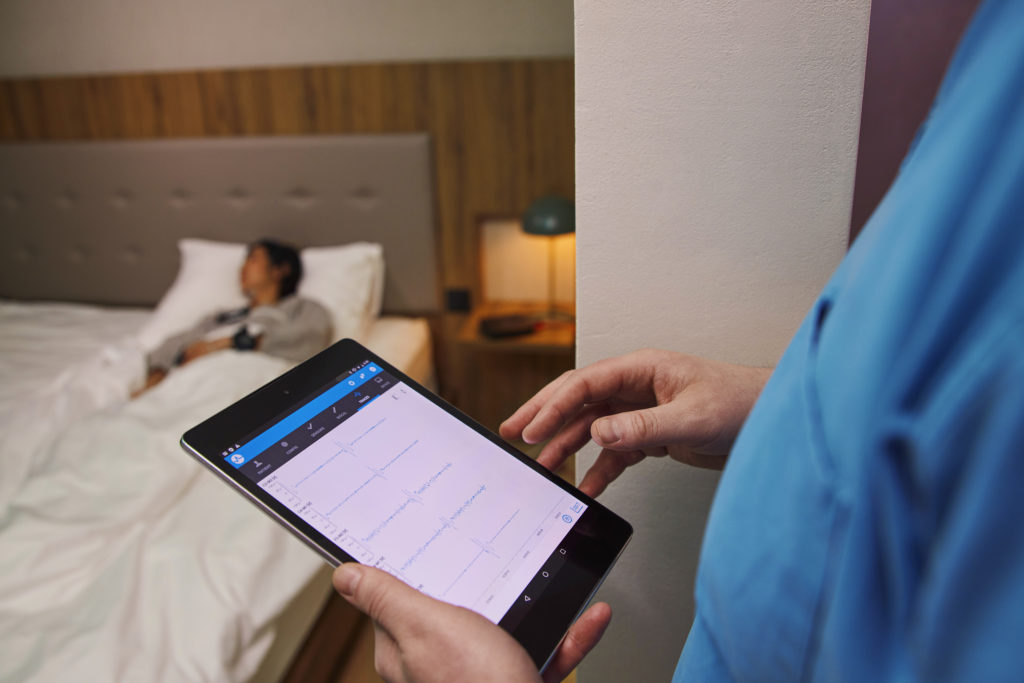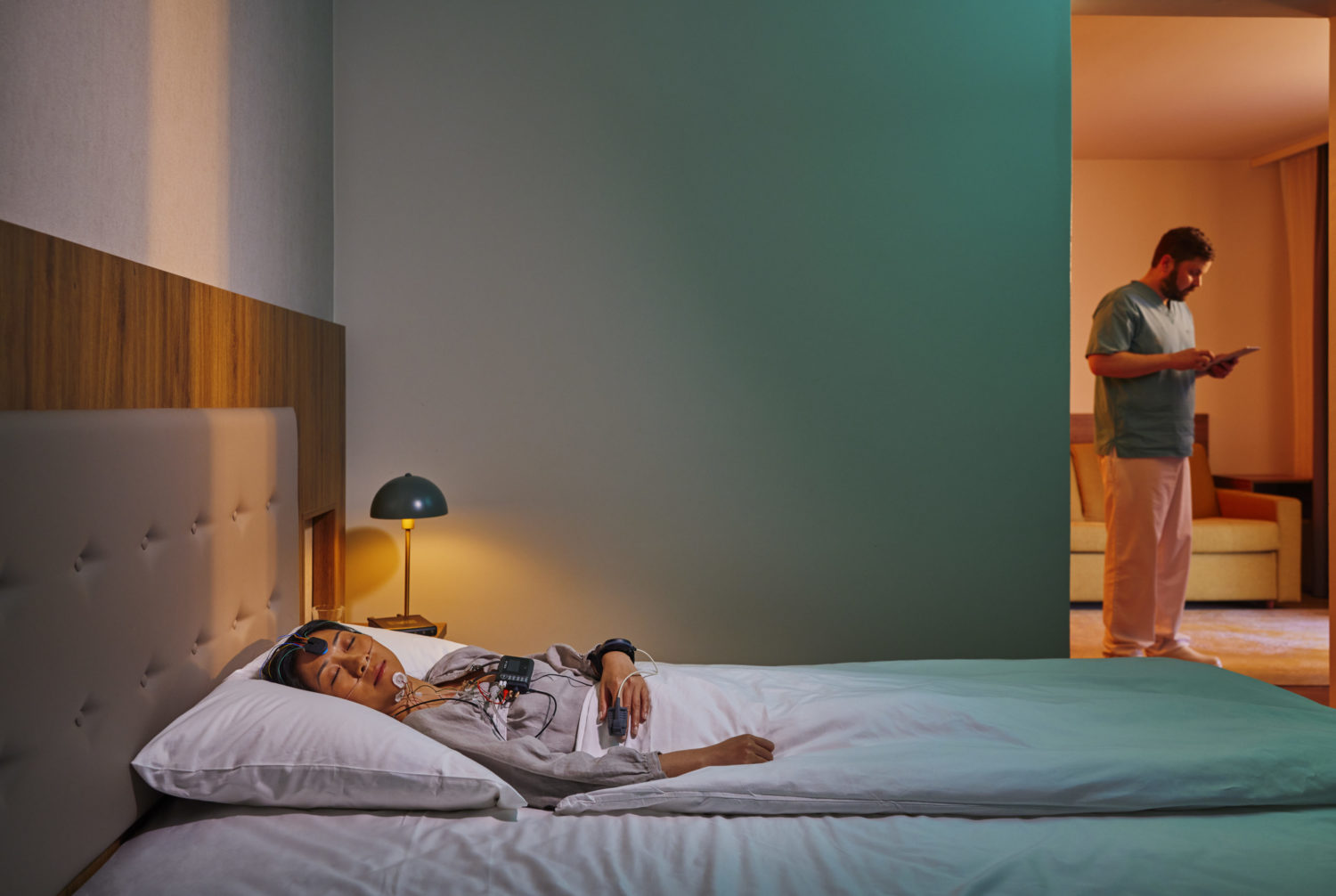One of the world’s most portable polysomnography (PSG) systems, the Nox A1s is transforming how sleep apnea patients experience sleep studies. With wireless capabilities, the Nox A1s enables patients to maintain their sense of independence as they move freely throughout the night. Unencumbered by wires, they can maneuver to the bathroom or get up for a glass of water, without the help of a sleep tech. A boundlessly versatile PSG, the Nox A1s is an ambulatory system that can meet patients where they are — in the home or in the hospital. Regardless of the location where the PSG system is used, there is a high degree of agreement between sleep studies. Research, published in Sleep and Biological Rhythms, found a similar sensor quality for airflow, oxygen, and respiratory effort for home and in-lab studies. Additionally, the apnea–hypopnea index scores did not differ.
“You can use this in an ambulatory mode, in which you set the patient up, have them come home with the test, and then have them come back and download the information,”
says Jay Hemnani, RPSGT, sleep lab manager at FusionSleep in Georgia.
“This PSG System is definitely the most leading edge in terms of the technology”
The New Frontier of Wireless PSG
Historically, PSG system wires could weigh heavy on a patient’s head, span several feet, and restrict a patient’s movement by attaching to a nightstand. If a patient rolled all the way around, they could wake up tangled in wires. The Nox A1s system solves these problems. With the Nox A1s, the patient is no longer tethered to the bedside. Wires are still present, but they are reduced, and attached only to the body. Bluetooth transmits all sleep study data while a backup copy is also stored on an internal hard drive for additional peace of mind. The shorter PSG wires travel from the patient’s head to their chest, while still leaving some slack for the patient to move comfortably.
“With this wireless technology, the patient can sleep on any side of the bed without feeling like they are pulling or tugging on anything,” Hemnani says.
FusionSleep switched to wireless polysomnography not long after the Nox A1s system became available. Prior to using the wireless system, patients in Hemnani’s sleep lab could not sprawl out over the entire bed. Bathroom breaks came with the risk of knocking a sleep sensor out of place and required assistance from the sleep tech.
“In the sleep lab, people will wake up and just lay there for 10 or 15 minutes and think about going to the bathroom, and eventually the tech will buzz in and ask them if they need anything,” explains Hemnani.
“With the Nox A1s system, they can just get up and go to the restroom on their own and not feel like they have to burden somebody,” he says. “I think that leads to higher sleep efficiency because they are able to get up on their own and not have lights turn on.”
A Seamless Sleep Study Hookup
The Nox A1s hookup is simple, leaving more time for sleep techs to attend to multiple patients. Historically, sleep techs had to individually hook up the head box, a pressure transducer, a body position sensor, a RIP sensor, and a snore sensor. Now, all the major sensors are incorporated into a single device, says Drew Lackner, Nox VP of sales and business development in the United States. The reduced amount of wiring also leads to a great reduction in the time it takes to hook up the patient.
“We are working on making it a more friendly experience for the patient, a healthier experience for the patient, and something that they are more willing to do,” says Lackner.
Patients are also free to move during the hook up process, allowing sleep techs to more easily work with diverse patient populations. For instance, pediatric patients can seek comfort by sitting in a parent’s lap while sleep techs connect the sensors.
“We have had a lot more success when using it with pediatric patients because it is a little bit less involved in terms of the hookup. Little kids like to move around a lot and that is usually not ideal,” says Hemnani.

Also, the Nox A1s paves the way to more face-to-face interactions with patients. Techs can use a tablet that syncs with the PSG system in real-time, so they can adjust the sleep study settings from the bedside. Overall, the level of flexibility seen with the Nox A1s is unmatched in the world of PSGs, the gold standard for diagnosing sleep apnea.
“It’s really a leap in technology,” says Lackner. “The future is now.”
References:
Yoon, DW, Hong, IH, Baik, I. et al. Evaluation of the feasibility and preference of Nox-A1 type 2 ambulatory device for unattended home sleep test: a randomized crossover study. Sleep Biol. Rhythms. 2019. 17, 297–304.
Kapur VK, Auckley DH, Chowdhuri S, Kuhlmann DC, Mehra R, Ramar K, Harrod CG. Clinical practice guideline for diagnostic testing for adult obstructive sleep apnea: An American Academy of Sleep Medicine clinical practice guideline. J Clin Sleep Med. 2017 Mar 15;13(3):479-504.
Nox Medical and FusionSleep have collaborated for years on improving sleep diagnostics.
Topic: Nox A1 PSG System





